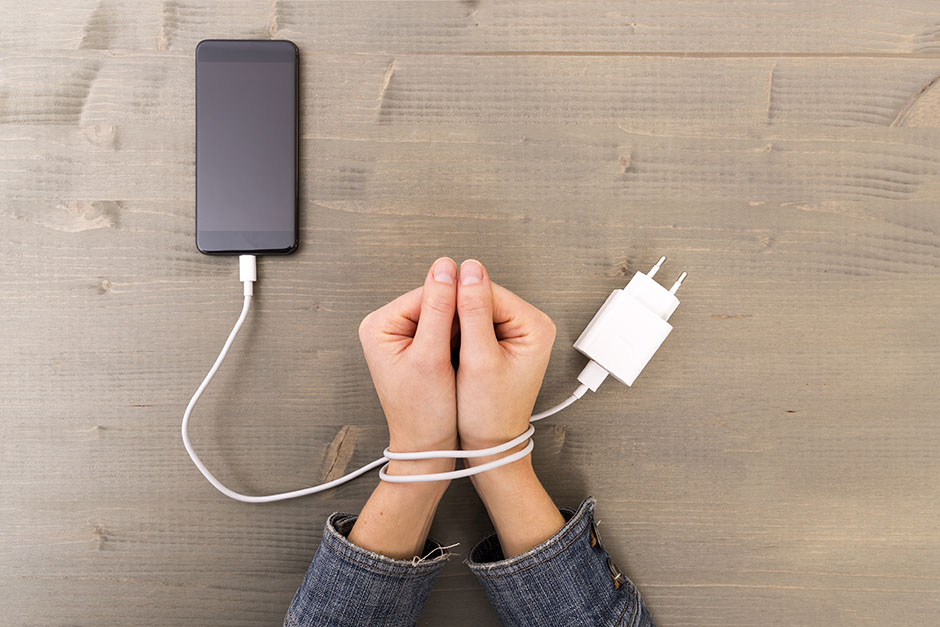Digital addiction, also known as technology addiction, is the compulsive use of digital devices despite negative consequences that the behavior has on a person’s life. While the percentage of adolescents who are digitally addicted is hard to estimate, recent research can help illuminate the scope of the problem. For example, digital addiction research from the Harris Poll found that six in ten Americans wish their family members would use digital devices less. Similarly, an IDC Research report on smartphone usage found that approximately 80% of smartphone owners check their smartphone immediately after waking up.

While digital addiction among adolescents is only a recent problem of the last two decades, the topic is broad and has multiple facets. In this article, we provide an overview of digital addiction in the context of adolescents. We discuss the causes of digital addiction, the types of digital addiction, and how parents can identify cases of digital addiction among their adolescents. Further, we provide information on current methods for treating digital addiction, and we detail actions a parent can take if they believe their child suffers from digital addiction.
Causes and types of digital addiction
Addictions start with behavior that releases dopamine, a hormone that makes a person feel optimistic and happy and is associated with the brain’s reward pathways. In an attempt to experience that dopamine release again, the person begins to engage in the behavior compulsively, to the extent that it negatively impacts the person’s life. A person who has a substance addiction will seek out the substance to keep experiencing a dopamine release, even at the cost of physical health consequences, depleting their savings, and fracturing interpersonal relationships.
Similarly, digital addictions can impact many facets of a person’s functioning including physical, emotional, vocational, academic, and interpersonal areas of functioning. However, instead of compulsive substance consumption, the affected adolescent compulsively uses digital technology. Attempting to experience a dopamine release, the adolescent picks up their phone or logs on to their computer around the clock.
Technology giants, particularly social media and gaming companies, have engineered their phone applications and websites to maximize user engagement, which refers to the amount of time that users spend on the company’s phone application or website each day. In an interview with the New York Times on digital addiction and kids, Dr. Jenny Radesky from the University of Michigan comments on how technology companies work to maximize user engagement. Dr. Radesky notes that “the design of modern technologies is purposefully habit-forming and programmed with the sort of variable rewards that keep humans engaged.” Unfortunately, as affirmed by Dr. Radevsky, maximizing user engagement often translates to maximizing dopamine-releasing activity, which can increase the risk of users developing a digital addiction.
Social media companies maximize user engagement through psychology-based techniques. For example, social media companies show users affirmation from their peers through “likes,” and gaming companies maximize user engagement through in-game rewards, such as points or frequent level completions. Gaining affirmation from peers and achieving repeated successes, even in a game, is enjoyable. However, if left uninterrupted, this pleasure-seeking behavior can become all-consuming for an adolescent.
Digital addiction refers broadly to addictive behaviors associated with any digital technology. However, there are different types of digital addiction, each with unique characteristics. Specific digital addictions include phone addiction, social media addiction, video gaming addiction, and internet addiction disorder. These types of digital addictions can overlap, such as when an adolescent compulsively uses social media applications on their phone and exhibits social media addiction and phone addiction simultaneously. Interestingly, the World Health Organization (WHO) included video gaming addiction as an official disorder in the International Classification of Diseases (ICD-11) manual.
Identifying digital addiction among adolescents

Parents may feel that their teen uses digital technologies excessively, but when do parents know if their teen has a digital addiction? After all, frequently using digital technology is not always harmful, and in many cases, such as with virtual schooling, digital technology is a productive tool for adolescent’s healthy development.
The difference between frequent digital technology use and a true digital addiction depends on both the child’s behavior and the impact of the child’s behavior. In an interview on digital addiction with Rewire, Dr. Craig Sawchuck of the Mayo Clinic’s Integrated Behavioral Health division stated, “Technology use crosses the line when a person starts to experience functional impairments… and they continue to use [digital technology] in spite of negative consequences.” Continued behavior despite adverse consequences from that behavior is a hallmark of an addiction, and it is a useful arbiter when determining if an adolescent’s use of digital technology has become a digital addiction.
Negative consequences of technology addiction can include poor school performance, failure to complete household chores, and sleep deprivation. When suffering from digital addiction, teens can appear unmotivated, and for many, it seems that all the teen cares about is using a digital device. Digital device usage can progress to take up endless hours a day. When digital technology use becomes a problem, teens can also experience intense mood swings and even depression. A study on digital addiction and depression published in the journal Psychopathology, for example, found that self-reported internet addicts were, on average, moderately to severely depressed.
Parents can also use the teen’s interactions with adults to help identify a possible digital addiction. The adolescent’s teachers or coaches may report the teen’s compulsive digital behavior, such as the teen constantly checking their phone during classes or coaching sessions. Parents may find themselves regularly asking their teens to stop using digital technology, too. For example, parents may find themselves frequently frustrated by their teen using his phone at the dinner table. Parent’s may realize that these interactions occur more and more regularly, and these emotionally-difficult interactions may be a sign that their teen has a digital addiction.
How to treat digital addiction
Fortunately, adolescents can break the cycle of digital addiction, and they do not have to have their digital addiction to impact their lives forever. Depending on the scale of the adolescent’s digital technology use, different home and professional interventions may be appropriate. These interventions can help the adolescent better understand when digital technology use is beneficial and when it can be harmful. Additionally, these interventions can help adolescents learn to exhibit better self-control over their behavioral patterns with digital technology.
If an adolescent is spending too much time with digital technology, one useful first step is for the parent to set limitations on the teen’s digital technology use. For example, parents can schedule technology-free time each day or establish technology-free zones in the house. Another useful family change is for family members to turn their phones off or to put their phones face-down on the table during dinner. Often, the adolescent meets these measures with irritability and anger, and these reactions may be further evidence that the teen has a digital addiction. Digital technology limitations can start small, and in some cases, they can be beneficial for the whole family, as adults can suffer from digital addiction, too.
In cases of full-blown digital addiction, adolescents typically need the help of trained medical professionals to change their behavioral patterns. In these cases, attempts to curb the teen’s digital technology use by the teen’s parents have often not only failed but have also resulted in a hostile home environment. When a digitally addicted teen loses access to a digital device, the teen may exhibit withdrawal symptoms that are similar to those experienced by a chemically dependent substance abuser. The teen may show repeated instances of irritability, anger, and even violence, and the teen may constantly attempt to circumvent his parent’s limitations. In some cases, digitally addicted teens continue to experience “phantom notifications,” an occurrence when the teen believes they received a digital notification, even when their digital device is off or is in another room.
Trained medical professionals can help treat an adolescent’s digital addiction using a variety of counseling methods. Counselors and psychologists can work with the adolescent to help the teen better understand the causes and effects of their digital technology usage. With this improved understanding, teens can work to control their impulses to use digital technology, and they can learn to recognize when their digital technology usage becomes harmful in their lives. Depending on the facility, digital addiction treatment may involve an inpatient program, an outpatient program, or a combination of both. The most effective treatment programs for adolescent digital addiction typically last several months, and they often have an ongoing follow-up component. Ongoing follow up helps ensure that teens do not relapse into their old, harmful behavioral patterns when they return home.
The Shepherd’s Hill Academy’s approach to digital addiction

Shepherd’s Hill Academy is a long-term nature-based boarding school for adolescent boys and girls, and the facility has dealt with adolescent digital addiction for the past 20 years, before the public recognized digital addiction as a risk for teens. Shepherd’s Hill Academy’s founders, Trace and Beth Embry, helped develop and provide some of the earliest treatment programs for adolescent digital addiction in the United States. Trace and Beth have been refining their behavioral treatment programs with each passing year.
When adolescents stay at Shepherd’s Hill Academy, they work with our onsite counselors and therapists for 12 to 18 months. During this time, adolescent residents will live and learn in a therapeutic and caring environment, where they can benefit from individualized treatment from trained professionals. With the facility’s programs being residential, Shepherd’s Hill Academy staff can connect with each adolescent on a deeper level than is possible with an outpatient program. Deeper relationships and developed trust between each teen and staff member help yield a more effective and lasting treatment.
At Shepherd’s Hill Academy, digitally addicted adolescents will have the opportunity to grow during a period of digital detox. Teens do not have regular access to digital devices while staying at Shepherd’s Hill Academy, and this distancing from digital devices can help each teen gain perspective on the impact of their past behavior.
In addition to distancing from digital devices, adolescents will engage in Shepherd’s Hill Academy’s unique wilderness hybrid program during their time in the program. This nature-based component of Shepherd’s Hill Academy requires teens to dwell in and maintain rustic cabins without internet access or electricity. Instead of spending time clicking through social media or playing video games, teens will complete outdoor projects and enjoy face-to-face interaction with their new peers. Shepherd’s Hill Academy’s programs also have an equine-therapy component, where teens take ownership of caring for our onsite horses. These outdoor experiences help each teen develop skills in team-building, leadership, and self-efficacy.
The Shepherd’s Hill Academy is a Christ-centered institution. However, residents do not have to learn or practice religion. The Shepherd’s Hill Academy has had adolescent residents from all 50 states and over 16 countries, from a variety of cultural and religious backgrounds.
Getting started at the Shepherd’s Hill Academy
Parents who are struggling with their teen’s digital technology usage should know that they are not alone. With proper treatment, a teen’s behavioral patterns with digital technology can change, and teens can learn to appreciate how excessive digital technology use can hurt them in the long run. Time at Shepherd’s Hill Academy can help achieve lasting behavioral change with enrolled adolescents, and it can also provide teens with a sense of hope for a brighter future.
To see if Sheperd’s Hill Academy may be right for your teen, please give us a call at (706) 703-4188 or contact us online. We can discuss your child’s unique situation, and we can discuss how Sheperd’s Hill Academy’s unique behavioral health programs may be useful for your child. We are also happy to arrange a private tour of our facility and to put you in touch with the parents of teens who have completed our program successfully.


